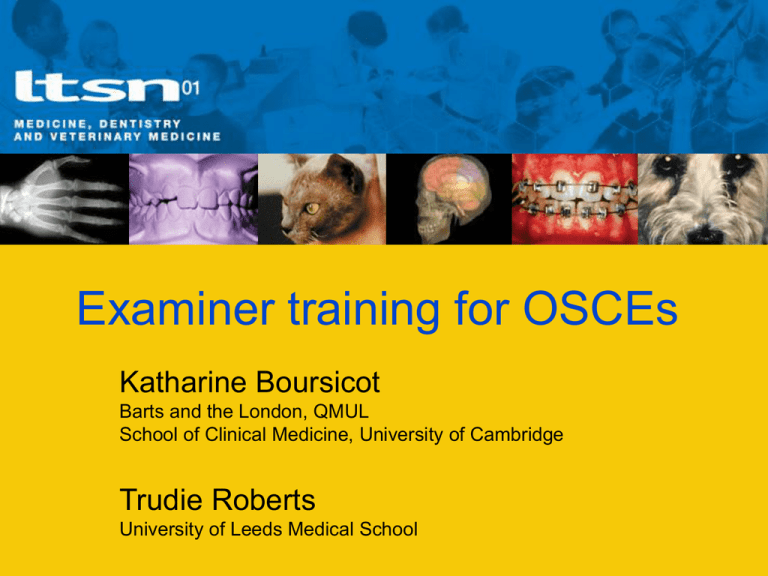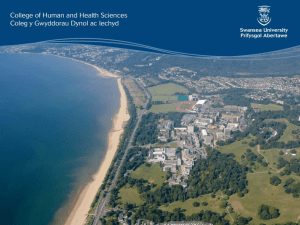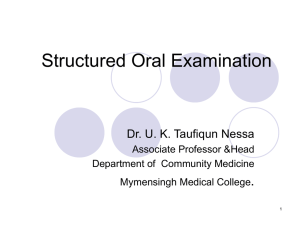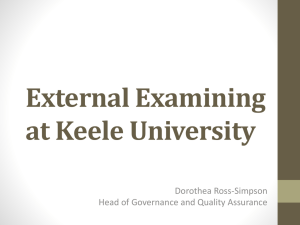26_LTSN_OSCE_examiner_training_workshop
advertisement

Examiner training for OSCEs Katharine Boursicot Barts and the London, QMUL School of Clinical Medicine, University of Cambridge Trudie Roberts University of Leeds Medical School Programme • • • • Principles of OSCEs for examiners Video marking Marking live stations Strategies for enhancing examiner participation in training http://www.ltsn-01.ac.uk Academic principles of OSCEs • The basics • What is an OSCE? • More academic detail • Why use OSCEs? • The role of examiners • Examiners in OSCEs http://www.ltsn-01.ac.uk The basics • For examiners who don’t know about OSCEs • A brief reminder for those who are familiar with OSCEs http://www.ltsn-01.ac.uk What is an OSCE? • • • • Objective Structured Clinical Examination http://www.ltsn-01.ac.uk OSCE test design Station http://www.ltsn-01.ac.uk OSCEs - Objective • All the candidates are presented with the same test http://www.ltsn-01.ac.uk OSCEs - Structured • The marking scheme for each station is structured • Specific skill modalities are tested at each station • • • • History taking Explanation Clinical examination Procedures http://www.ltsn-01.ac.uk OSCEs – Clinical Examination • Test of performance of clinical skills: not a test of knowledge • the candidates have to demonstrate their skills http://www.ltsn-01.ac.uk More academic detail • Why use OSCEs in clinical assessment? • Improved reliability • Fairer test of candidate’s clinical abilities http://www.ltsn-01.ac.uk Why use OSCEs in clinical assessment? • Careful specification of content • Observation of wide sample of activities • Structured interaction between examiner and student • Structured marking schedule • Each student has to perform the same tasks http://www.ltsn-01.ac.uk Characteristics of assessment instruments • Utility = • • • • • Reliability Validity Educational impact Acceptability Feasibility Reference Van der Vleuten, C. The assessment of professional competence: developments,research and practical implications Advances in Health Science Education 1996, Vol 1: 41-67 http://www.ltsn-01.ac.uk Test characteristics • Reliability of a test/ measure • reproducibility of scores across raters, questions, cases, occasions • capability of differentiating consistently between good and poor students http://www.ltsn-01.ac.uk Sampling Domain of Interest Test Sample Test Sample http://www.ltsn-01.ac.uk Reliability • Competencies are highly domain-specific • broad sampling is required to obtain adequate reliability • across content i.e. range of cases/situations • across other potential factors that cause error variance i.e. • testing time, examiners, patients, settings, facilities http://www.ltsn-01.ac.uk OSCE : blueprint History Explan Exam Procedure CVS Chest pain Disch drugs Cardiac BP RS Haemoptysis Smoking Resp Peak flow GIS Abdo pain Gastroscopy Abdo Repro Amenorrhoea Abnormal smear Cx smear NS Headache Eyes MS Backache Hip Generic Pre-op assess Consent for post mortem PR Ophthalmosc IV cannulation Blood trans rea http://www.ltsn-01.ac.uk Test characteristics • Validity of a test/measure • the test measures the characteristic (eg knowledge, skills) that it is intended to measure http://www.ltsn-01.ac.uk Model of competence Professional authenticity Does Shows how Behaviour~ skills/attitudes Knows how Knows Cognition~ knowledge Miller GE. The assessment of clinical skills/competence/performance. Academic Medicine (Supplement) 1990; 65: S63-S67. http://www.ltsn-01.ac.uk Validity of testing formats Professional practice assessment Does Shows how Knows how Knows Performance assessment: OSCEs, long/short cases, OSLERs, etc Problem-solving assessment: EMQs, SEQs Knowledge assessment: MCQs http://www.ltsn-01.ac.uk Test characteristics: Educational impact Relationship between assessment and learning Curriculum Assessment Teacher Student http://www.ltsn-01.ac.uk Test characteristics • Feasibility • cost • human resource • physical resources http://www.ltsn-01.ac.uk Test characteristics • Acceptability • tolerable effort • reasonable cost • Acceptability • • • • • • doctors licensing bodies employers patients/consumer groups students faculty http://www.ltsn-01.ac.uk The role of examiners in OSCEs • • • • General Types of stations Standard setting Practice at marking http://www.ltsn-01.ac.uk The role of examiners in OSCEs • To observe the performance of the student at a particular task • To score according to the marking schedule • To contribute to the good conduct of the examination http://www.ltsn-01.ac.uk The role of examiners in OSCEs • It is NOT to: • • • • • Conduct a viva voce Re-write the station Interfere with the simulated patient’s role Design their own marking scheme Teach http://www.ltsn-01.ac.uk Types of OSCE stations • • • • History taking Explanation Clinical examination Procedures http://www.ltsn-01.ac.uk Communication skills • Stations involving patients, simulated patients or volunteers • Content vs process i.e what the candidate says vs how the candidate says it http://www.ltsn-01.ac.uk Clinical skills • People • Professional behaviour • Manikins • Describe actions to the examiner http://www.ltsn-01.ac.uk The examiner’s role in standard setting • Use your clinical expertise to judge the candidate’s performance • Allocate a global judgement on the candidate’s performance at that station • Remember the level of the examination http://www.ltsn-01.ac.uk Global scoring Excellent pass Very good pass Clear pass Borderline Clear fail http://www.ltsn-01.ac.uk Borderline method Test score distribution Checklist 1. Hs shjs sjnhss sjhs sjs sj 2. Ksks sksmsiqopql qlqmq q q qkl 3. Lalka kdm ddkk dlkl dlld 4. Keyw dd e r rrmt tmk 5. Jfjfk dd 6. Hskl;s skj sls ska ak akl ald Borderline score distribution 7. Hdhhddh shs ahhakk as TOTAL Pass, Fail, Borderline P/B/F Passing score http://www.ltsn-01.ac.uk Regression based standard Checklist 1. Hs shjs sjnhss sjhs sjs sj 2. Ksks sksmsiqopql qlqmq q q qkl 3. Lalka kdm ddkk dlkl dlld 4. Keyw dd e r rrmt tmk 5. Jfjfk dd 6. Hskl;s skj sls ska ak akl ald 7. Hdhhddh shs ahhakk as TOTAL X = passing score Checklist Score X Overall rating 1 2 3 4 5 1 2 3 4 5 = = = = = Clear fail Borderline Clear pass V Good pass Excellent pass 1 2 3 Clear fail Borderline Clear pass 4 V Good pass 5 Excellent pass http://www.ltsn-01.ac.uk Practice at marking • Videos • Live stations • Mini-OSCE http://www.ltsn-01.ac.uk http://www.ltsn-01.ac.uk Strategies for enhancing examiner participation 1. 2. 3. 4. CME Job plan/ part of contract Specific allocation of SIFT Experience for post-graduate examinations 5. Payment http://www.ltsn-01.ac.uk







